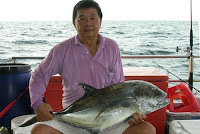 |
| A popping specimen. |
 |
| Sometimes big one can be caught at night. |
 |
| Some can be caught by random popping. |
 |
| This nice fish was hooked during one of the GT frenzies. |
 |
| Another one from night popping. |
The giant trevallies (Charanx ignobilis) are flat bodied fighters. They are normally found near reefs and islands. On the westcoast of Peninsular Malaysia, the methods used by sport anglers are usually popping and jigging. And the hotspots are Pulau Jarak and Tekun Perak. In the South China Sea, they are very common around oil rigs. Sometime trolling can also be an effective method to catch them.
When hooked, GTs would just bored down deep, using their flat bodies and the sea current to their fullest advantage.
All my GTs were released alive.













